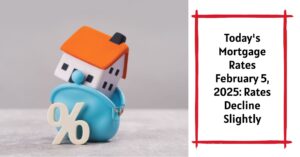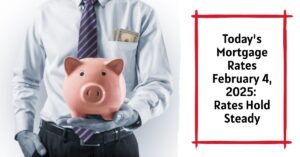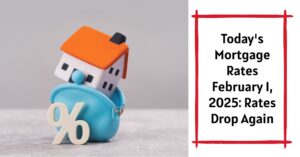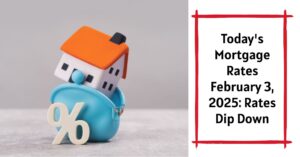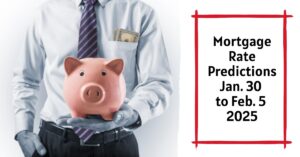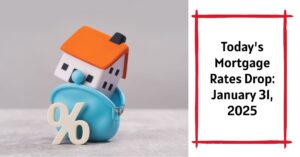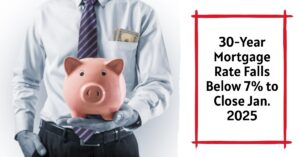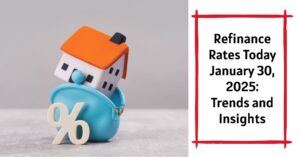As of February 5, 2025, today's mortgage rates have seen a slight decline, with the current average interest rate for a 30-year fixed mortgage standing at 6.95%. This is down a modest 6 basis points from 7.01% the previous week. The decrease comes amidst a backdrop of economic turbulence related to recent policy shifts and global economic uncertainty. With projections indicating that rates will stabilize rather than drop significantly throughout the remainder of the year, potential buyers may find it advantageous to lock in current rates on a mortgage sooner rather than later.
Today's Mortgage Rates – February 5, 2025: Rates Decline Slightly
Key Takeaways
- Current Average Rate: The average rate for a 30-year fixed mortgage is 6.95% (Bankrate).
- Recent Trends: Rates have inched lower despite ongoing economic concerns.
- Future Projections: Experts forecast rates to close 2025 at around 6.5%.
- Types of Loans: Different types of mortgages have varying rates (e.g., 15-year, VA, FHA).
- Impact of Personal Factors: Your credit score, down payment, and loan term significantly affect the rates you may receive.
Understanding Mortgage Rates
Mortgage rates fluctuate due to various economic factors, including inflation, interest rates set by the Federal Reserve, and the general state of the housing market. Here are some key components to consider:
- Credit Score:
- Borrowers with higher credit scores, typically above 670, often qualify for lower interest rates.
- A good credit score indicates to lenders that borrowers are less likely to default on their loans.
- Down Payment:
- A larger down payment translates to lower risk for lenders. Thus, putting down at least 20% of your home's purchase price can significantly reduce your interest rate and help you avoid private mortgage insurance (PMI).
- Traditionally, a larger upfront payment reduces the overall loan amount, which diminishes the lender's exposure.
- Loan Terms:
- Except for the standard 30-year fixed mortgage, there are also 15-year and 20-year terms. Shorter loan terms usually carry lower interest rates, while longer loans generally have higher rates but lower monthly payments.
- Knowing which term fits your budget and future plans is essential for financial planning.
- Type of Rate:
- A fixed-rate mortgage provides a consistent interest rate and monthly payment for the entire duration of the loan, making it a secure option for stability in budgeting.
- Conversely, an adjustable-rate mortgage (ARM) may start with lower rates, but these rates can fluctuate over time based on market conditions, so they come with higher risks.
Each factor affects your overall borrowing costs and can make a significant difference over the life of your loan. Understanding these variables will empower you to make informed decisions when approaching lenders.
Monthly Payment Calculations for Common Mortgage Amounts
Understanding how mortgage rates translate into actual monthly payments can better prepare you for homeownership. Here, we will outline the estimated monthly payments for several common mortgage amounts using an average interest rate of 6.95% for a 30-year fixed mortgage.
Monthly Payment on $150,000 Mortgage
- For a $150,000 mortgage at 6.95% interest:
- Estimated Monthly Payment: $995.09
- Thus, if you borrow $150,000, you would pay approximately $995.09 each month. Over 30 years, you would pay a total of $358,629.60, which includes $208,629.60 in interest.
Monthly Payment on $200,000 Mortgage
- For a $200,000 mortgage at 6.95% interest:
- Estimated Monthly Payment: $1,327.45
- If your mortgage amount is $200,000, your monthly payment would be around $1,327.45. Over the term, this amounts to $478,681.20, with $278,681.20 in interest.
Monthly Payment on $300,000 Mortgage
- For a $300,000 mortgage at 6.95% interest:
- Estimated Monthly Payment: $1,991.18
- With a mortgage for $300,000, you can expect to pay roughly $1,991.18 per month. Over 30 years, this totals $716,428.80, including $416,428.80 in interest.
Monthly Payment on $400,000 Mortgage
- For a $400,000 mortgage at 6.95% interest:
- Estimated Monthly Payment: $2,654.90
- If you take out a mortgage for $400,000, your monthly payment would be about $2,654.90. The total over the loan term would be $1,174,169.00, with $774,169.00 in interest.
Monthly Payment on $500,000 Mortgage
- For a $500,000 mortgage at 6.95% interest:
- Estimated Monthly Payment: $3,318.63
- Borrowing $500,000 would result in a monthly payment of approximately $3,318.63. Over 30 years, you would repay a total of $1,366,176.80, including $866,176.80 in interest.
These estimated payments give a clearer picture of what to expect when taking on different mortgage amounts at the current rates. It's important to understand that despite these figures, the bulk of your payment initially goes toward interest, especially in the early years of a mortgage.
Current Average Mortgage Rates by Loan Type
As of February 5, 2025, here is a quick overview of average interest rates for different loan types (Bankrate):
| Loan Type | Average Interest Rate |
|---|---|
| 30-Year Fixed Rate | 6.95% |
| 20-Year Fixed Rate | 6.72% |
| 15-Year Fixed Rate | 6.24% |
| 10-Year Fixed Rate | 6.07% |
| 5/1 Adjustable Rate Mortgage | 6.15% |
| 30-Year Fixed FHA Rate | 6.98% |
| 30-Year Fixed VA Rate | 6.74% |
This table demonstrates that fixed-rate mortgages dominate the landscape, providing stability for homeowners in uncertain economic times. Buying a home often represents one of the most significant financial commitments most individuals will undertake, so being aware of these rates is crucial for budgeting.
Recommended Read:
Mortgage Rates Trends for February 4, 2025
Mortgage Rate Predictions Next Week: Jan 30 to Feb 5, 2025
Factors Influencing Mortgage Rates Today
It is essential to understand the elements that impact today's rates. The Federal Reserve's decisions around interest rates play a significant role, along with overall economic conditions. Below, we explore key considerations that could influence rates:
- Economic Policies:
- Current policies from government leaders are directly tied to borrowing costs. Recent changes in tariff and taxation policies have created market uncertainties, making lenders cautious.
- Policy trends under the current administration suggest looming Federal Reserve meetings could bring further discussions regarding economic stimulus.
- Inflation Rates:
- Inflation has a historical correlation with interest rates. As inflation increases, lenders often raise rates to maintain their profit margins.
- Recent data showed inflation rates moderating, which may lead to more stable mortgage rates in the near term. The Consumer Price Index (CPI) reported lower increases recently, suggesting some relief in housing costs.
- Market Demand for Housing:
- With inventory being low and many potential buyers waiting on the sidelines, it creates a tight market for housing. This competitive environment leads to increased buyer interest, subsequently influencing rates.
- Factors like the popularity of urban areas and remote work trends also shift market dynamics, affecting supply and demand.
- Employment Figures:
- Regular job growth and a lowering unemployment rate often push consumer confidence, potentially increasing demand for housing and affecting rates.
- Recent reports indicated positive trends in job creation, contributing to economic stability which positively influences consumer spending.
Understanding these elements can help borrowers navigate their options in a fluctuating economy. Keeping an eye on economic indicators and government policies allows potential homebuyers to seize the right opportunities more effectively.
The Importance of Locking In a Rate
Given the current volatility in the market, it’s wise for potential buyers to lock in a mortgage rate when they find a rate that fits their budget. This rate lock typically occurs at the time you apply for your loan and ensures you won’t be affected by any rate increases that may occur during the processing of your application. Many lenders offer rate locks of 30, 45, or even 60 days, giving you time to finalize the purchase of a home.
When considering a rate lock:
- Evaluate current market trends and economic forecasts to assess the likelihood of rate increases.
- Speak with your lender about the implications of locking in your rate, such as any fees involved.
- Understand your timeline for home purchasing so you can select an appropriate lock period.
Keeping a Pulse on Mortgage Rates
Staying informed about mortgage rates is crucial for anyone considering homeownership. With today's average rates slightly lower, prospective buyers should assess their financial position and take action if they find a favorable loan. Given the uncertainty in the market, it may not be wise to delay home purchases, particularly if you are financially prepared.
By analyzing the monthly payments on various mortgage sizes and understanding the broader economic factors at play, you can make informed decisions regarding your future home purchase. As you venture into the world of home ownership, keep informed not only about rates but also about your local market conditions, as these can significantly impact your home buying experience.
Work with Norada in 2025, Your Trusted Source for
Real Estate Investing
With mortgage rates fluctuating, investing in turnkey real estate
can help you secure consistent returns.
Expand your portfolio confidently, even in a shifting interest rate environment.
Speak with our expert investment counselors (No Obligation):
(800) 611-3060
Recommended Read:
- Mortgage Rates Forecast for the Next 3 Years: 2025 to 2027
- 30-Year Mortgage Rate Forecast for the Next 5 Years
- 15-Year Mortgage Rate Forecast for the Next 5 Years
- Why Are Mortgage Rates Going Up in 2025: Will Rates Drop?
- Why Are Mortgage Rates So High and Predictions for 2025
- NAR Predicts 6% Mortgage Rates in 2025 Will Boost Housing Market
- Mortgage Rates Predictions for 2025: Expert Forecast
- Will Mortgage Rates Ever Be 3% Again: Future Outlook
- Mortgage Rates Predictions for Next 2 Years
- Mortgage Rate Predictions for Next 5 Years
- Mortgage Rate Predictions for 2025: Expert Forecast
- Mortgage Rate Predictions: Why 2% and 3% Rates are Out of Reach
- How Lower Mortgage Rates Can Save You Thousands?
- How to Get a Low Mortgage Interest Rate?
- Will Mortgage Rates Ever Be 4% Again?
